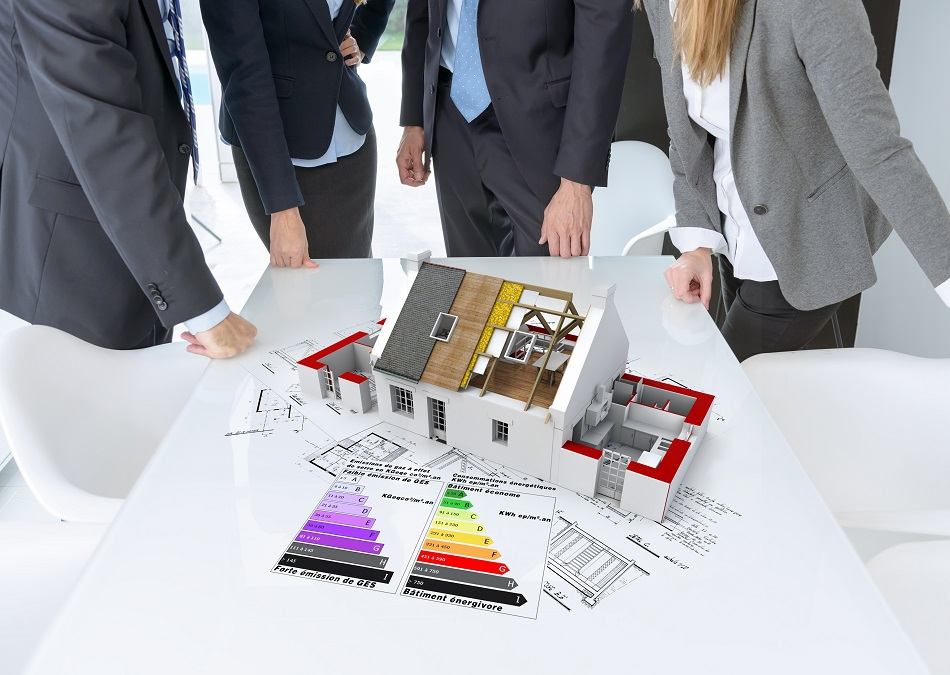
Image Credit: Franck Boston/Shutterstock.com
During building and renovating, long term energy savings can be achieved through design considerations during the initial stages of planning. As the sun is our natural heater, advantage can be taken of all it has to offer. For example, when buying a new home choose a block or plot which has year-round natural warming sunlight and/or low-angled winter sun. When buying a pre-owned home, look for a home that is not shaded from the sun by large leafy mature trees or positioned in a beautiful, but potentially damp habitat.
Unless they are well-insulated, open-plan homes are also a potential energy waster. Doors help to keep the heat locked in and the cold out. Shutting a door on unused and unheated rooms will help keep heat in the areas which need it the most. It is surprising how such simple energy-saving procedures can be overlooked.
Windows can potentially allow in annoying draughts which bring in cold air and wastes heat. If there is no double-glazing, installation of window protection systems such as shutters can keep a house warm in winter and cool in summer. Draughts can also be prevented in areas such as air vents, construction joints between walls, and gaps around and between windows.
Heating and Cooling - Reducing the Energy Used for Heating and Cooling
Insulation plays an important role in keeping a house cool in summer and warm in winter. Walls, doors, and ceilings must be well insulated. Invest in window coverings to keep your house warm during winter, and allow for suitable ventilation to keep it cool during summer.
The amount of energy used can be substantially reduced by adding efficient controls and by making full use of solar energy such as the sun. Using less energy for heating is the single most effective way to reduce a home's contribution to global environmental problems. Replacing an old or inefficient heater with a newer high-efficiency design is another way to reduce the amount of energy used for heating.
When buying a new energy-efficient heater, it should be the proper size for the area required to heat. When looking for central air conditioning and heat pumps, look for energy efficiency, performance, and cost. For maximum efficiency, look for equipment that has the highest seasonal energy efficiency ratio (SEER). A heat pump with a higher SEER rating for cooling mode is also often more efficient in heating mode, rated using HSPF (heating seasonal performance factor).
An energy audit can ascertain the usage of wastage in your home through analysis of energy bills, insulation, heating, and cooling systems, electrical systems, and appliances, so it can be worth spending a bit to save long term. Besides, many systems can now be controlled by a laptop or mobile phone. The advantage is, you can control home heating and cooling systems remotely ensuring that energy is provided only when required.
Lighting - Energy Savings Through Energy Efficient Lighting
The United States spends about one-quarter of its electricity on lighting at a cost of more than $37 billion annually. This could be reduced by 50 to 75 percent simply through new energy-efficient light bulbs, according to the Center for Climate and Energy Solutions.
The initial cost of energy-efficient lighting solutions typically costs more than traditional lighting such as incandescent lighting. However, the significant energy savings and a longer bulb life can offset this initial outlay. For example, incandescent bulbs are cheap to buy but unfortunately, they need to be replaced frequently. CFLs can last about four to 10 times longer than incandescents.
At the top of the very best energy-efficient tree is LED that can shine its radiance for up to 25,000 hours (up to 25 years), compared to the 10,000-hour lifetime of the CFL. The technology behind this highly efficient option is continually improving, and LED bulbs are becoming increasingly cost-competitive with CFLs. According to the New York Times, LEDs outsold all other types of bulbs for the first time in 2017.
The second phase of the 2007 lighting efficiency rules is scheduled for 2020. It means lightbulbs that put out less than 45 lumens per watt will be prohibited. Currently, only compact fluorescent and LED bulbs can meet that requirement, so if you haven’t changed now is the time. It’s a shift that is both saving consumer’s money and also cutting greenhouse gas emissions.
Water Heating - Heating Water Efficiently
Up to a quarter of the energy consumed in households is used for water heating. By choosing a suitable water heater and by using energy-efficient water heating strategies, monthly water heating bills can be reduced. Using and wasting less hot water in the home can reduce water heating costs. The water heating costs can also be reduced by lowering the thermostat setting on the water heater.
Adding insulation to your hot water tank can reduce standby heat loss of up to 45 percent, this, in turn, can save up to nine percent in water heating costs. Insulating hot water pipes can increase water temperature and reduce heat loss.
Thermodynamic panels are being promoted as a potential option to heat water cheaply and efficiently. Yet this technology is still in the early stages of development and the current initial financial outlay can be high in terms of the financial return. Conversely, according to the latest data, solar panel installations in the US are on an upward trajectory and have officially surpassed two million with a predicted four million installations by 2023.
This article was updated on 24th February, 2020.
Disclaimer: The views expressed here are those of the author expressed in their private capacity and do not necessarily represent the views of AZoM.com Limited T/A AZoNetwork the owner and operator of this website. This disclaimer forms part of the Terms and conditions of use of this website.